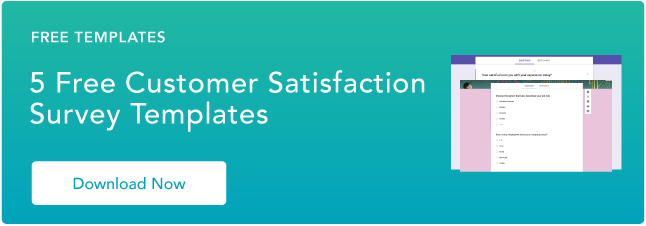User Experience Surveys
User experience surveys are meant to help you improve your user/customer experience, so you can adjust your long-term product and customer service strategy.
These are extensive surveys that give you in-depth customer feedback and let you know why users are using your product and what they like and dislike about it. User experience surveys are important to send in the early stages of the product life cycle.
How Companies Use User Surveys
- Understand your target market in the early stages.
- Customer segmentation.
- Improve product features.
- Collect feedback on certain features.
- Improve the customer experience.
- Reduce and prevent churn.
- Reviews and testimonials.
1. Understand your target market in the early stages.
When you're developing a SaaS product and you're in the early stages, it's important to interview your first users. This will help you profile your ideal customer so you know everything about your target market at the beginning.
In a user experience survey, you could ask questions like:
- What's the best way to reach you? (Do they prefer emails or cold calls?)
- What are your decision-making criteria?
- What are you looking for in a product like ours?
- What kind of sales material do you like to see?
- How did you find out about us?
You'll want to conduct these surveys as early as possible in the product life cycle.
2. Customer segmentation.
User surveys on your website can help you segment your web visitors, prospects, leads, and customers.
For example, in a user survey, you can ask a customer questions like:
- What industry are you in?
- What's your job title?
- How big is your team?
Knowing this information will help you segment your audience into different buyer personas and target them efficiently for marketing. For customer service, you'll be able to segment users based on this information for customer satisfaction or NPS surveys. Plus, you can provide better service the more you understand your customers.
3. Improve product features.
Another way to use user surveys is to improve product features. You can ask users how they use your product, what it helps them accomplish, and what sticking points they come across in their day-to-day life. You can also find out what features are missing, and if they had to replace your product with another, what it would be and why.
This type of user survey is important for your product development and product marketing teams to understand what the customer is looking for in your product. This will be especially helpful for your customer service team so you can reduce calls requesting certain features.
4. Collect feedback on certain features.
You can also use user surveys to collect feedback on certain features that are rolling out. For example, you can ask what product features are most important. If you ask these types of questions (after some segmentation questions), you'll find out which features are most important to your high-value customers.
Then, you can ask an open-ended question like "What other features would you like us to build?" All of this is meant to improve the customer experience so you can truly delight your customers.
5. Improve the customer experience.
A great way to use user surveys is to find user experience gaps and determine how you can improve the customer experience. Questions angled toward this will help you predict customer churn and how your customers perceive your product.
These questions might look like this:
- What did you want to accomplish today by using our product and were you able to?
- Was it easy to accomplish your goal?
- Was there anything you couldn't accomplish that you wanted to?
6. Reduce and prevent churn.
Similar to the point above, user surveys can help you prevent churn by learning about the customer journey. You can also ask why dormant users haven't used your product and get their take on what you can do to make your product better.
If customers have already churned, you can ask them why. You'll ask why they canceled their account, why they didn't use your product, and what would make them change their mind. This information will help prevent churn in the future.
7. Reviews and testimonials.
You can also use user surveys to collect reviews and testimonials. These questions would be similar to NPS questions, like how likely is someone to recommend your product. For those who rate lower, you might ask what you can do better. For those that rate higher, you can ask them to leave a review if they left a high number.
How to Conduct User Surveys
- Define the scope of your survey.
- Write simple questions.
- Be explanatory and detailed.
- Avoid biased, leading questions.
- Get people to participate.
- Analyze your findings.
1. Define the scope of your survey.
Before you conduct a user survey, it's important to define the scope of the survey. One survey might not be able to do all of the things we've discussed above (tell you about your ideal audience, customer segmentation, and product feature feedback). These might be broken down into several user surveys, more focused on one or two topics or goals.
The first step to conducting a user survey is to determine what the goal is. Then, you can focus on writing the questions you want to ask.
2. Write simple questions.
Writing good questions is essential for a useful user survey. A good question will deliver a reliable and insightful answer. However, a poorly written question won't give you any insight.
Usually, user surveys will have a mix of closed questions (like multiple choice, or yes and no), or open-ended questions (where respondents can answer any way they want).
Either way, the questions should be simple, not confusing, or filled with jargon. Again, when questions aren't simple, you won't get reliable answers.
Additionally, with close-ended questions, it's important to consider that the option a user wants to submit isn't there -- in which case you can have an "other" option where they can specify.
For any type of question, make sure you aren't asking too many things at once. Remember: One question at a time. If you're interested in learning more about writing questions, you can read this blog post.
3. Be explanatory and detailed.
The instructions for a user survey should be clear and detailed, while also being simple. Directness is really important here. While some people might not like reading long instructions, it's always better to have clear instructions that are longer, than confusing, short instructions.
4. Avoid biased, leading questions.
To avoid bias, your questions should have an equal number of positive and negative options. For example, if you ask participants if they think somewhat positively or completely positively about a product, it's clear the answers are biased to a positive answer. Introducing bias or leading questions to a user survey will make the results unusable.
Leading questions could be, "How helpful is our software?" Instead, you could ask, "Do you think our software is helpful?" These little changes make a big difference when it comes to analyzing the results of your user survey.
5. Get people to participate.
The only way that user surveys are helpful is if people respond. Especially enough people to provide statistically significant data.
To get people to participate, consider the length of your survey, structure your survey in a way that makes it easy to respond, or offer incentives. I'm sure you've seen surveys where all participants are entered into a raffle to win a gift card.
6. Analyze your findings.
The last step to conducting a user survey is analyzing your findings and summarizing them in a way where you know what actionable steps you're going to take next.
Creating user surveys is a great way for a SaaS company to get direct feedback, target their audience more effectively, and provide the best customer experience.
Survey Creation
.png?width=112&height=112&name=Image%20Hackathon%20%E2%80%93%20Horizontal%20(24).png)


![16 best free online survey makers and tools [+ recommendations]](https://53.fs1.hubspotusercontent-na1.net/hubfs/53/free-online-survey-maker-1-20251028-2654831.webp)


![How to conduct survey analysis like a data pro [all my tips + secrets]](https://53.fs1.hubspotusercontent-na1.net/hubfs/53/survey-results-1-20241031-6355381.webp)
![Leading questions: What they are & why they matter [+ Examples]](https://53.fs1.hubspotusercontent-na1.net/hubfs/53/leading-questions-hero.webp)
![How long should a survey be? The ideal survey length [New data]](https://53.fs1.hubspotusercontent-na1.net/hubfs/53/how%20long%20should%20a%20survey%20be_featured.png)



